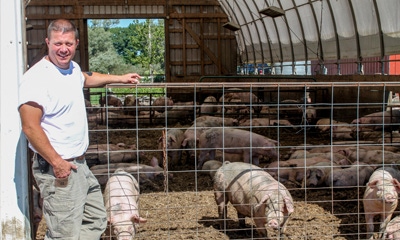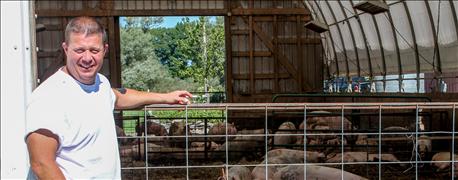October 3, 2016

Back in 2007, American Agriculturist reported Steve Winkler’s meat marketing success with “going natural.” Winkler has grown his Lucki 7 Livestock farm at Rodman, N.Y., from 12 pigs, 20 chickens and 12 steers in 1997 to marketing 800 to 1,000 hogs, 30 beef animals, 700 chickens and 7,000 dozen eggs annually.
He knows how to price his products. Still, he was excited to learn about the Livestock Yield and Price Calculator developed by Matt LeRoux, marketing specialist with Cornell Cooperative Extension’s South Central Regional Ag Team. “I’ve been using this calculator from the start with my buyers, processors, producers and consumers,” reports the producer.

CALCULATED PROFITS: Steve Winkler has a special calculator in his livestock pricing toolbox that helps close deals. Photo by Brian P. Whattam.
Calculating meat cut margins
Producers set their base and premium pricing for beef, pig, goat or lamb. Add in trucking, delivery, processing and any value-added costs, plus desired markup by cut or hanging weight. The calculator does the math to show if you’re at, above or short of your profit goal.
“This calculator is designed to aid producers in figuring how to price individual cuts to be sure they can profit and balance consumer demand against the breakout of the most highly desired cuts plus the lesser-in-demand cuts across a full carcass,” explains LeRoux.
“Using Matt’s formulas created a common matrix that allowed a major grocery chain and me to achieve consistency in pricing,” adds Winkler, “even when production costs fluctuate. If I update my base price, the calculator figures the through-cost to him.”
When a major distributor interested in buying pork called Winkler, they worked the numbers to close the deal. “This distributor had not purchased directly from a farm in decades,” recalls the livestock producer. “We plugged numbers into the calculator back and forth for three months until the pricing suited each of us. That distributor is now my main deliverer to Whole Foods and other major retailers in the Northeast.”
Winkler, a proponent of partnership building, is part of a new U.S.-Canadian organic hog network. The calculator is one of the tools they use together to help determine best pricing.
It works for direct consumer-marketing, too. The spreadsheet explains expected yield and type of cuts so consumers can plan their freezer space. And, Winkler notes, “The tool showed me the black-and-white pricing difference for volume buyers compared to one- and two-animal consumers that buy once a year.”
The secret: Knowing your costs
Best results come from your own numbers. “Track processing and marketing costs for one typical animal,” suggests LeRoux. “Note the hanging weight and weigh all the cuts. Have your current price list for the market channels you use. And, know the base price per pound of hanging weight you need to be at to stay profitable.”
Know your inputs and the carcass price you need, adds Winkler. Then, the tool will show if you’re getting the price you want or if you’re below cost and need to make changes.
LeRoux’s 2011-2014 work to help vegetable growers with market channel assessment sparked livestock industry interest to develop the Livestock Yield and Price Calculator. New York Farm Viability Institute provided funding for both projects.
Meat producers aren’t restricted by the narrow perishable produce marketing window constraining vegetable growers. They have by-the-cut and freezer trade sales as options, giving them more opportunities to set pricing to target markets for higher margins, points out LeRoux.
Even so, “selling cuts of meat with different values versus whole animals can create challenges for maintaining profit margins,” confirms NYFVI Director David Grusenmeyer. “Tools like this pricing calculator are essential for maintaining a profitable business.”
Check meatsuite.com later this fall for a link to the Livestock Yield and Price Calculator. LeRoux can be reached at 607-272-2292.
Dunn writes from Mannsville, N.Y.
Learn more about the meat calculator
Cornell’s Matt LeRoux will conduct a number of workshops on the Livestock Yield and Price Calculator from November through March 2017. He asks producers bring their processor’s invoice and meat cut weights from a typical animal to the workshops.
He’ll also be a featured speaker at the Northeast Livestock Conference, Nov. 11-12, at Watertown, N.Y. See ccejefferson.org for details.
You May Also Like




